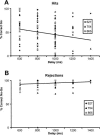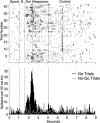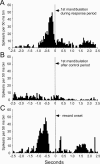Neural correlates of a default response in a delayed go/no-go task
- PMID: 16596978
- PMCID: PMC1389779
- DOI: 10.1901/jeab.2005.86-04
Neural correlates of a default response in a delayed go/no-go task
Abstract
Working memory, the ability to temporarily retain task-relevant information across a delay, is frequently investigated using delayed matching-to-sample (DMTS) or delayed Go/No-Go tasks (DGNG). In DMTS tasks, sample cues instruct the animal which type of response has to be executed at the end of a delay. Typically, performance decreases with increasing delay duration, indicating that working memory fades across a delay. However, no such performance decrease has been found when the sample cues exist of present vs. absent stimuli, suggesting that pigeons do not rely on working memory, but seem to respond by default in those trials. We trained 3 pigeons in a DGNG task and found a similar default response pattern: The diverging slopes of the retention functions on correct Go and No-Go trials suggested that pigeons by default omitted their response following No-Go stimuli, but actively retained task-relevant information across the delay for successful responses on Go trials. We conducted single-cell recordings in the avian nidopallium caudolaterale, a structure comparable to the mammalian prefrontal cortex. On Go trials, many neurons displayed sustained elevated activity during the delay preceding the response, replicating previous findings and suggesting that task-relevant information was neurally represented and maintained across the delay. However, the same units did not show enhanced delay activity preceding correct response suppressions in No-Go trials. This activation-inactivation pattern presumably constitutes a neural correlate of the default response strategy observed in the DGNG task.
Figures





Similar articles
-
Maintenance in working memory or response selection? Functions of NMDA receptors in the pigeon "prefrontal cortex".Behav Brain Res. 2004 Aug 31;153(2):497-506. doi: 10.1016/j.bbr.2004.01.007. Behav Brain Res. 2004. PMID: 15265648
-
Delayed matching-to-sample: A tool to assess memory and other cognitive processes in pigeons.Behav Processes. 2016 Feb;123:26-42. doi: 10.1016/j.beproc.2015.07.002. Epub 2015 Jul 9. Behav Processes. 2016. PMID: 26165174
-
Operant behavioral analysis of memory loss in monkeys with prefrontal lesions.Brain Res. 1982 Sep 23;248(1):51-9. doi: 10.1016/0006-8993(82)91146-5. Brain Res. 1982. PMID: 7127142
-
The prefrontal cortex and working memory: physiology and brain imaging.Curr Opin Neurobiol. 2004 Apr;14(2):163-8. doi: 10.1016/j.conb.2004.03.003. Curr Opin Neurobiol. 2004. PMID: 15082320 Review.
-
Neural changes after training to perform cognitive tasks.Behav Brain Res. 2013 Mar 15;241:235-43. doi: 10.1016/j.bbr.2012.12.017. Epub 2012 Dec 20. Behav Brain Res. 2013. PMID: 23261872 Free PMC article. Review.
Cited by
-
Immediate early gene fingerprints of multi-component behaviour.Sci Rep. 2020 Jan 15;10(1):384. doi: 10.1038/s41598-019-56998-4. Sci Rep. 2020. PMID: 31941919 Free PMC article.
-
Hippocampal memory consolidation during sleep: a comparison of mammals and birds.Biol Rev Camb Philos Soc. 2011 Aug;86(3):658-91. doi: 10.1111/j.1469-185X.2010.00165.x. Epub 2010 Nov 11. Biol Rev Camb Philos Soc. 2011. PMID: 21070585 Free PMC article.
-
Time devours things: how impulsivity and time affect temporal decisions in pathological gamblers.PLoS One. 2014 Oct 8;9(10):e109197. doi: 10.1371/journal.pone.0109197. eCollection 2014. PLoS One. 2014. PMID: 25296184 Free PMC article.
References
-
- Asaad W.F, Rainer G, Miller E.K. Neural activity in the primate prefrontal cortex during associative learning. Neuron. 1998;21:1399–1407. - PubMed
-
- Baddeley A. Working memory: Looking back and looking forward. Nature Reviews Neuroscience. 2003;4:829–839. - PubMed
-
- Colombo M, Cottle A, Frost N. Degree of representation of the matching concept in pigeons (Columba livia). Journal of Comparative Psychology. 2003;117:246–256. - PubMed
-
- Colombo M, Frost N, Steedman W. Responses of ectostriatal neurons during delayed matching-to-sample behavior in pigeons (Columba livia). Brain Research. 2001;917:55–66. - PubMed
Publication types
MeSH terms
LinkOut - more resources
Full Text Sources

